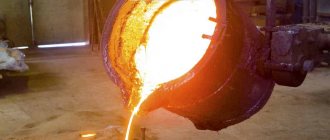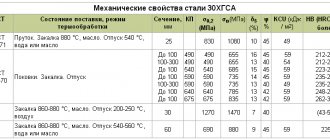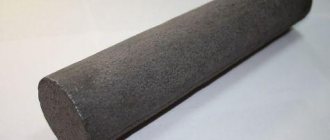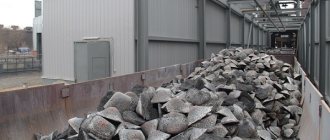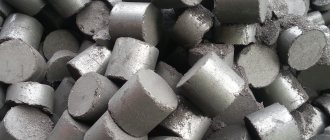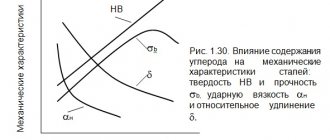In fact, it seems that the question is insignificant and can be answered without any problems. However, in reality, a person cannot find the answer to the question posed, even if he turns to the Internet for help. This is really quite an interesting question, which I decided to look into, as they say, thoroughly. Let's try to talk about this in more detail now.
In order to understand this issue in more detail, you first need to understand the characteristics of steel and the characteristics of cast iron.
How much does 1 kg of cast iron cost?
Cost of cast iron scrap
| Category | Price per kg | Price per ton |
| 17A - cast iron scrap overall | 6-7 rubles | 9000-10000 rubles |
| 19A - dimensional cast iron scrap, in pieces | 6-7 rubles | 8500-9000 rubles |
| 20A - oversized scrap, piece weight no more than 5 tons | 6-7 rubles | 9000-10500 rubles |
| 22A - oversized scrap (plumbing waste) | 6-7 rubles | 8500-9000 rubles |
Characteristics of cast iron
Iron and carbon are also found in cast iron. If we talk about carbon, then cast iron contains at least 2%. In addition, steel is alloyed using various additional components, including manganese, silicon, and so on.
Depending on the crystal lattice, cast iron can be divided into several options:
- White - the color is determined by the content of cementite in the composition; only malleable cast iron is made from it;
- Gray - in this case there is a fairly significant percentage of graphite in the composition;
- Malleable is a high-strength type of cast iron that produces an increased level of impact resistance;
- High strength and ultimate.
The melting point of this material averages 1160 – 1250 degrees. Melting depends on the carbon content of cast iron. The more carbon, the lower the melting point.
How to distinguish cast iron cookware from aluminum?
Cast iron is a dark metal, almost black. Aluminum - light gray, silver. And, besides weight, the difference can be... fragility.
Interesting materials:
Can a tablet be used as an e-reader? Can old asphalt be used? Can I use just the base and top? Is it possible to leave Car Sharing at the airport? Is it possible to go to the movies for 18+? Is it possible to wear an autumn coat in winter? Can you wear Yeezy Boost in winter? Is it possible to bury a relative in the grave? Can pancake batter be stored in the refrigerator? Is it possible to lay laminate flooring on a wooden floor?
Characteristics of steel
If we talk about steel in simple and accessible language for the common man, then steel is just an alloy of carbon and iron. The percentage of iron is from 45%, and carbon up to 2%. Among other things, it is worth understanding that there are a huge number of steel grades, which means that its composition can be completely different. This may include nickel, chromium, manganese and so on. Carbon in this case is used to give the metal properties of strength and durability.
Steel can be roughly divided into: high, low and medium alloy. Among other things, steel also differs in its carbon content. These options are called low, medium and high carbon.
Steel melts at temperatures from 1450 to 1520 degrees.
How to distinguish cast iron from steel at home
The development of industry and the creation of synthetic materials cannot detract from the advantages and benefits of traditional materials. These include cast iron and steel. These are some of the oldest familiar alloys to human civilization.
The technology of repair and design work often includes various types of processing. It could be:
- mechanical
- chemical
- thermal
- electrolytic
- plasma and other types of processing.
Despite the fact that cast iron and steel differ from each other by a tiny difference in carbon content, the methods and methods of influencing factors on these alloys differ and require different ways of the same method to influence the shape and structure of the metal.
Factors affecting the processing of steel and cast iron
In order not to waste money and resources, it is very important to know how to identify cast iron or steel.
- Selecting a welding electrode
- drill sharpening angle
- drilling and milling mode
These are not all the factors that can complicate the life and work of a person who incorrectly determines the type of metal. Reducing mechanical, strength and violating guaranteed repair intervals is a much greater evil that can damage production and the budget in the event of an error.
Visual definition
How can you distinguish cast iron from steel visually without resorting to destructive testing methods?
If there is a question about welding a cracked section of a part or even a piece that has fallen off, then it is possible to examine the breakdown or structure of the crack.
The metal on a scrapped cast iron part will most likely be dark gray in color with a matte surface. Under the same conditions, the steel fracture will have a light gray, almost white color, with a glossy sheen.
The nature of cracks on the surface of high-carbon alloys is similar to a crack on pottery; low-carbon alloys are prone to plastic deformation and for this reason the crack has the shape of a rupture of plastic material.
Based on surface defects, only cast iron can be identified, which was poured into the mold at a low temperature, was not processed later, and a decorative paint layer was not applied. On such a product, hemispherical small grains are visible, formed due to non-shedding due to low temperature.
Don't forget about the correct visual method for identifying material. Soviet, modern and foreign GOSTs require the presence of material markings on all cast products. On domestic casting, the icons MF, HF, KCH - this means cast iron. L45, 45HL, 110G2S - indicates the use of steel casting for this element.
Mechanical determination by drilling
High-strength cast iron with nodular graphite is very similar in quality and visually to steel products. Testing a product by tearing it using a tensile testing machine is not entirely justified or reasonable.
To do this, you can select a non-working, inconspicuous area on the product and drill it not to the full depth with a drill of minimum diameter. The structure of cast iron is such that the chips are not able to form into a twisted loach. Graphite inclusions, even if they are not visible, crumble the chips at the stage of their formation.
Such shavings grind into dust in your hands and leave a black mark on your hands, like the lead of a simple pencil.
Steel shavings are capable of forming a loach longer than the length of the drill itself, and do not crumble in your hands. At high speeds it has a tarnished color on the surface.
Mechanical determination by grinding
You can approach the issue of determining the material using a grinder (angle grinder). As in the previous method, we select a section that is not a friction plane, contact pad or other important design element. With the machine turned on, we come into contact with the surface under study and monitor the shape and color of the sparks.
In cast iron products this will be a short spark with a reddish tint on the sprocket at the end of the track.
In metal products, the sheaf of sparks will be relatively larger, the tracks will be longer, and the sparks will be dazzlingly white or yellow.
If there is uncertainty and uncertainty in the method and your assessment, then you can take a known material, for example, a cast iron cauldron in the corner of the garage and check what sparks fly when processed with a grinder. At the same time, we should not forget that a number of special-purpose steels, especially heat-resistant ones, produce a spark of minimal size, with a short track and cherry red color.
This material does not cover methods exotic for home use:
- spectral analysis
- microscopic analysis
- weighing and volume determination.
But for home needs, the above methods are more than enough. Regardless of the method and method of determining the material, try to use diagrams, drawings and other information for your unit or product. The amount of information on the World Wide Web is off the charts and can reach the most remote corner of a workshop or garage.
Features of caring for cast iron cookware
After any type of cleaning, measures must be taken to create a protective layer on the cast iron to prevent corrosion in the future:
- turn on the oven at 180 degrees, warm it up;
- grease the frying pan with oil (any oil except olive oil), applying a thin layer;
- place the product in the oven, bottom up, leave for 60 minutes;
- turn off the cabinet, do not take out utensils for another hour;
- Remove the pan, rinse, wipe dry, and put away for storage.
Cast iron should always remain a little greasy - this will allow it to maintain protection against corrosion for a long time. In the future, you should follow these care tips:
- Always wait for the product to cool down and only then start washing it;
- after each wash, lubricate the item with vegetable oil and heat for 1-2 minutes;
- do not leave the pan with ready-made liquid food for a long time - after cooking, pour it into another container;
- do not use aggressive detergents, brushes, or abrasives on a regular basis, they wash off the protective layer and the cast iron rusts faster;
- to remove burnt food, soak the dishes in warm water, then easily remove the remains with a washcloth;
- do not forget to use the dishes regularly so that they do not stand idle;
- do not wash in the dishwasher;
- Do not cook acidic food, which corrodes the protective layer.
High-quality care of cast iron will keep the product in excellent condition, eliminate the appearance of rust, while maintaining its non-stick properties and ability to retain heat.
Sources
- https://jgems.ru/metally/chugun
- https://stroyres.net/metallicheskie/vidyi/chyornyie/chugun/ponyatie-osobennosti.html
- https://metallicheckiy-portal.ru/articles/chermet/raznoe/chto-takoe-chugun-sostav-i-soderzhanie-ugleroda-v-splave/
- https://elton-zoloto.ru/raznoe/skolko-procentov-ugleroda-imeetsja-v-sostave-chuguna.html
- https://lux-stahl.ru/metally-i-splavy/izbytok-alyuminiya-v-chugunah-vyglyadit-kak.html
- https://ometalledo.ru/soderzhanie-ugleroda-v-chugune-i-stali.html
- https://www.syl.ru/article/304510/chto-takoe-chugun-svoystva-sostav-poluchenie-i-primenenie
- https://sakhkor.ru/materialy/vidy-chuguna.html
- https://morflot.su/procentnoe-soderzhanie-ugleroda-v-chugune/
- https://metallvsegda.ru/poleznoe/chto-takoe-chugun-sostav-i-soderzhanie-ugleroda-v.html
Iron and steel production
As for the production of cast iron, the process is exactly the same as for steel, special blast furnaces are used, and cast iron is made from iron ore. In addition, coke and sinter are used. The furnace also has a lower hole where hot air with a high oxygen content should be supplied.
The moment coke burns, it releases carbon dioxide on its own, which in turn releases carbon monoxide. Subsequently, the process of converting ore into cast iron occurs.
As for the manufacture of steel, there are practically no distinctive features. The steel itself is made from cast iron, where the content of carbon, sulfur, manganese and other elements is artificially reduced. The alloy can be obtained exclusively in oxygen converters or open-hearth furnaces.
Which metals are often confused
Cast iron products are confused with analogues of other metals, which may visually look similar. For example, when a person hands over the remains of machine tools, old radiator systems, fittings, fittings, and plumbing components.
Most often, confusion occurs in comparison with steel, iron or aluminum. Fortunately, you can find the differences even at home. It is enough to understand how they differ. This may be color, sound upon contact, strength characteristics, presence or absence of magnetic properties. In our article we will analyze the most available verification methods in detail.
Differences between steel and cast iron
To distinguish steel from cast iron, you need to know several important nuances:
- Steel products weigh less compared to cast iron counterparts.
- Rolled steel is light, cast iron is almost black.
- Cast iron can be broken with a strong hammer blow, while steel cannot.
- Steel is suitable for stamping, but high-carbon iron alloy is usually used only for casting.
You can also make a heating comparison to distinguish cast iron from steel: the first material will take longer to heat up, but cool down more slowly.
Industry challenges
Today, cast iron casting has dubious prospects. The fact is that due to high costs and large amounts of waste, industrialists are increasingly abandoning cast iron in favor of cheap substitutes. Thanks to the rapid development of science, it has long been possible to obtain higher quality materials at lower costs. Environmental protection plays a major role in this issue and does not accept the use of blast furnaces. It will take years, if not decades, to completely convert iron smelting to electric furnaces. Why so long? Because it is very expensive, and not every state can afford it. Therefore, all that remains is to wait until mass production of new alloys is established. Of course, it will not be possible to completely stop the industrial use of cast iron in the near future. But it is obvious that the scale of its production will fall every year. This trend began 5-7 years ago.
Story
The documented history of cast iron starts from the 1st millennium BC:
- Smelting was mastered by the Chinese and their neighbors.
- From the 5th century BC, the period of decorative iron casting began.
- 600 years later, coins appeared in China.
The appearance of the alloy in Europe dates back to the 14th century, in Russia – two hundred years later. Interest increased due to the suitability of cast iron as a material for cannons and cannonballs.
Eglinton Tournament Bridge (completed c. 1845), North Ayrshire, Scotland, built of cast iron
Since the time of Queen Victoria, fireplaces have become the most popular product in the “civil segment” among the British.
Cast iron coal iron
The heyday of the cast iron industry in Russia dates back to the 18th century:
- Bridges and rails appeared.
- Cast iron pots were invented in the Urals - the number one cookware for the Russian stove. Later they were supplemented with frying pans.
- By the end of the century, Russia had become the world leader in the production of cast iron.
The original bridge across the Tey from the north (finished in 1878)
The openwork products of Kasli craftsmen have gained world fame.
The method of molding for casting artistic castings of complex shapes, invented by the Kasli people, is still in demand by machine builders today.
How to distinguish steel from cast iron with a magnet?
The development of industry and the creation of synthetic materials cannot detract from the advantages and benefits of traditional materials. These include cast iron and steel. These are some of the oldest familiar alloys to human civilization.
The technology of repair and design work often includes various types of processing. It could be:
- mechanical
- chemical
- thermal
- electrolytic
- plasma and other types of processing.
Despite the fact that cast iron and steel differ from each other by a tiny difference in carbon content, the methods and methods of influencing factors on these alloys differ and require different ways of the same method to influence the shape and structure of the metal.
How to distinguish cast iron from metal - Metalist's Handbook
Among the metals produced in one technological process, some of the most common are steel and cast iron. Despite the fact that one is made as a result of alteration of the other, these metals differ significantly from each other, both in their composition and in their use in the economy.
